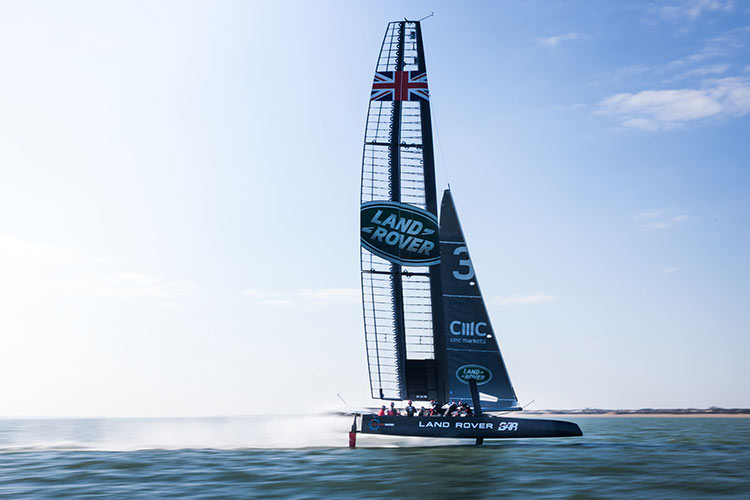Like many other cutting edge technologies – artificial intelligence, big data analytics – additive manufacturing (3D printing) has been incorporated into daily use at Land Rover BAR with the help of the team’s Technical Innovation Group (TIG). In this case, TIG partner Renishaw, a global metrology firm which manufactures metal additive manufacturing machines, as well as working with the more familiar 3D printing in plastics for its own prototyping.
TIG project manager, George Sykes of PA Consulting commented, “We use 3D printing at three different levels within the team. The simplest level is as a prototyping and visualisation tool. We manufacture a large number of custom parts and 3D printing allows us to make full size prototypes in-house before we commit to a design.”
The 3D printer sits in the Land Rover BAR design office, and with little more than the click of a mouse will create a plastic version of almost anything the designers plan to create.
“The prototyping process is really useful when we are trying to develop something,” said Land Rover BAR’s Chief Technology Officer, Andy Claughton. “It allows us to get our hands on it, put it in place on the boat or link it up with other parts of the system and see potential issues and refine the design before we commit to the production of the final piece.”

The team has its own, fully equipped traditional machine shop, and it has an extensive composites team. Between them, these facilities can make almost anything, but if the final part can be 3D printed then that’s the option that will be used. One of the big advantages in the system is that the cost can be significantly reduced.
An example is the end cap for the boat’s bowsprit. This is a complex shape, designed to reduce the aerodynamic drag. It was ideal for 3D printing in plastic because there was no load involved, and a single item was required. In years gone by this would have been built in carbon fibre to the finish and standard of a piece of custom furniture, and at great expense thanks to the time and skill of those involved. Now, once the design has been developed it can be produced in a handful of hours for a few pounds.
“But the top level of our 3D printing programme is the metal additive manufacturing supplied by Renishaw,” continued Sykes. “The manufacture of custom parts in metal is the cutting edge of this technology.”
The components are manufactured from paper thin layers (typically 0.05 mm) of fine metallic powder (cornflour consistency). The system works in an argon inert atmosphere – similar to that inside a light bulb; heat can be applied to melt the metal powder without it burning; or reacting with oxygen or impurities found in air. The heat is applied using a laser beam – this is directed using software controlled mirrors, and focused to accurately weld the areas required to create the part.
One of the earliest components the Land Rover BAR team created using this technology was a custom sheave case for the pulley in the daggerboard lift line. There was a high compressive load involved and it needed good resistance to wear; so metal was the ideal choice. All high strength metals have a higher density (weight per volume) than carbon fibre, so to keep weight down the final design was hollow. It would have been very difficult to make this part any other way than additive manufacturing.

“The potential of additive manufacturing in terms of saving weight and improving efficiency is tremendous,” explained Andy Claughton. “For example, we took a long hard look at our hydraulics system. Before 3D printing came along all the parts in this system would have been manufactured by taking metal away from a solid block. The shapes that you can create with this method are limited, so the design is limited and so too is the efficiency.
“Hydraulic fluid doesn’t take kindly to going around hard corners for instance, and there is a loss of power when it has to do so. With traditional techniques this might be the only way you can manufacture the part, but with additive manufacturing you can build it with smooth rounded corners that significantly improves efficiency in the fluid transfers involved.
“In addition to the improvements in efficiency, we can now build it much more lightly as we are only adding material specifically where it is needed. In the past, the geometry of manufacture on a lathe or other cutting tool meant that some material couldn’t be removed and we would have to carry around the excess weight. No longer.”
Renishaw has manufactured several parts for the hydraulics, and while the team are reluctant to reveal too much design detail, it has said that weight in a new AM manifold design was reduced by 60%, with an increase in performance efficiency of better than 20%.
David Ewing, Product Marketing Engineer at Renishaw’s Additive Manufacturing Products Division, commented, “Our involvement with Land Rover BAR is also helping to raise the bar in additive manufacturing. It’s a complex manufacturing option and there are considerations both in component design and process expertise. The best applications are ones which use the minimum amount of material to achieve the design requirements, offer a functional benefit in service and have been designed with the manufacturing method in mind. Our work on hydraulic parts for the team is a perfect example.”
“Renishaw is at the top of this particular game and they have really helped us out with their facilities. This is one technology that’s here to stay and its role within our build processes will only increase in the future,” concluded Andy Claughton.


